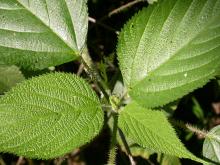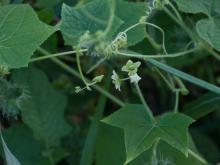Wildflowers, Grasses and Other Nonwoody Plants
Media

Species Types
Scientific Name
Laportea canadensis
Description
Wood nettle, or stinging nettle, often forms dense stands in bottomland forests, streamsides, and other places. There, canoeists, anglers, and others try to avoid touching its stinging hairs!
Media

Species Types
Scientific Name
Daucus carota
Description
Queen Anne’s lace is many things to many people — roadside wildflower, noxious introduced weed, wild edible, medicinal herb, delightful cut flower. In Missouri, it blooms May through October.
Media

Species Types
Scientific Name
Helianthus annuus
Description
Whether you see the wild form or any of the many cultivated varieties, this poster child of the sunflower family cultivates its own sunny impression. Common sunflower is also the state flower of Kansas.
Media

Species Types
Scientific Name
Sicyos angulatus
Description
Bur cucumber is a nonwoody, native, annual vine common in low, moist soils. It can spread across an area 20 feet wide, covering the ground and nearby shrubs. Note its lobed, gourd-family leaves, curly green tendrils, clusters of prickly, green, oval fruits, and 5-lobed, cream-colored flowers.
See Also
About Wildflowers, Grasses and Other Nonwoody Plants in Missouri
A very simple way of thinking about the green world is to divide the vascular plants into two groups: woody and nonwoody (or herbaceous). But this is an artificial division; many plant families include some species that are woody and some that are not. The diversity of nonwoody vascular plants is staggering! Think of all the ferns, grasses, sedges, lilies, peas, sunflowers, nightshades, milkweeds, mustards, mints, and mallows — weeds and wildflowers — and many more!





















